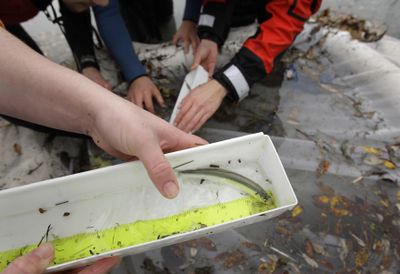Salmon run project begins
Study will track fish on dam-free river

PORT ANGELES, Wash. – Scientists know what two dams did nearly a century ago to the Elwha River’s legendary salmon runs.
Now they get a historic chance to find out what they still don’t know: Given a dam-free path, will a river ecosystem agree to march backward in time?
Come 2012, they’ll find out. In a project whose scope and size hasn’t been attempted in the U.S., experts will remove the 105-foot Elwha Dam and the 210-foot Glines Canyon Dam on the Elwha River on Washington’s Olympic Peninsula in an extraordinary experiment to restore a river from mountain to sea.
Jerry Freilich, research coordinator for Olympic National Park, said the answers, whatever they may be, will provide scientists with a wealth of new information.
“This is a very important research opportunity,” he said. “It’s the one that’s going to be in every textbook for the next 50, 100 years. It’s the granddaddy of them all.”
Scientists who have flocked to this wet, wooded peninsula in anticipation of the long-awaited event have an opportunity to answer a career’s worth of questions:
How quickly will salmon return to the 45-mile river after decades away? How will their return alter the habitat of everything from shrews to black bears? And how will the release of sediment trapped behind the dams – enough to fill six football stadiums – reshape the estuary?
“These questions haven’t been asked on this scale,” said Bradley Smith, dean of the Huxley College of the Environment at Western Washington University. It’s the largest removal of its type and presents unique factors because most of the watershed is in a national park.
The university and Peninsula College in Port Angeles share $1 million in National Science Foundation grants to study the ecological effects of dam removal, one of few souces of money for this type of research.
It may be 30 years before the full extent of recovery is known.
But one recent morning, marine biologist Anne Shaffer and students from both schools tackled those questions with a fish survey at the mouth of the Elwha, which drains northward into the Strait of Juan De Fuca from the Olympic Mountains.
Shaffer kept count while others sifted through a large seine they had run through the estuary: a baby threespine stickleback, three surf smelts and one cutthroat trout.
It’s a quiet time, so Shaffer didn’t expect to find many fish, but she knows juvenile salmon and forage fish use the estuary and marine areas off shore to spawn, feed and migrate.
“We can start to understand how they use it and how to restore it,” said Shaffer, with the state Department of Fish and Wildlife.
Dam construction stopped the flow of sediment to the river mouth. Diking and bulkheading further shrunk areas where salmon could rest, feed and acclimate to saltwater before heading off to sea. The release of 18 million cubic yards of sediment from the dams will deliver sand back to the rough, stony shore and improve the environment for fish.
The Elwha produced about 390,000 salmon and sea-run trout in 1910, including coho, pink, sockeye and chinook salmon and steelhead. By 2005, the number of wild native sea-run fish was only about 3,000.
Jim Bolstrom, with the Lower Elwha Klallam Tribe, which led the fight to tear down the dams, remembers seeing plenty of chinook as a kid and hearing tales of 100-pound fish.
“We’d like to restore all that pristine habitat … and restore the river back to its natural state,” said the tribe’s senior restoration field supervisor.
Built in the early 1900s, the concrete dams provided hydroelectric power for a local paper mill and a growing community. But the dams didn’t include fish passages, so migrating salmon and trout were confined to the lower five miles of the river.
After Congress passed the Elwha Act in 1992, the Department of Interior concluded that tearing down the dams was the only way to fully restore the river and its native salmon runs.
Scientists think it will take one to five generations, two to 20 years, for fish to establish a self-sustaining population on the entire Elwha.
In one study, geneticist Gary Winans is taking fin clips of steelhead for DNA analysis to be able to distinguish and monitor native, hatchery and neighboring fish that may recolonize the watershed.
“We’re trying to figure out the genetic nature of the population out there now, anticipating that things will change,” said Winans, with NOAA’s Northwest Fisheries Science Center in Seattle.
Scientists believe salmon provide nutrients when they lay eggs and die. They’re a massive fertilizer that feeds an extensive foodweb, from flies to hawks.
“If you take the species out, you have ramifications throughout the ecosystem,” said Brian Winter, the park’s Elwha project manager. “Once you get fish back there, what kinds of changes are we going to see in the vegetation, wildlife and terrestrials?”
Kurt Jenkins is tracking the location of mammals along the river, including otters and spotted skunks, to see how their movements may change when salmon return.
“What really excites me is to do this type of baseline study knowing that in the next five years, there’s going to be a major change in the system,” said Jenkins, a research wildlife biologist with the U.S. Geological Survey.
These are hardly the first dams to be removed. More than 750 dams have been removed in the past century, according to American Rivers. But the Elwha is the largest and certainly most watched.
“This will be successful ultimately,” said George Pess, supervisory research fishery biologist with Northwest Fisheries Science Center. “We don’t need to teach an ecosystem what to do. We just need to give it the opportunity to do it.”